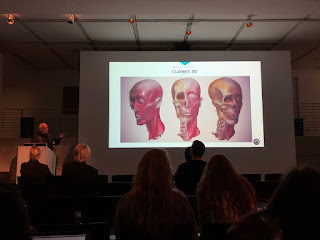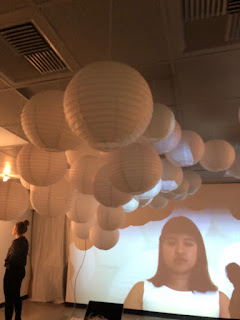Event #3: Weak or No Signal
I attended the final MFA showcase of the graduating class of 2018 called "Weak or No Signal." This showcase will help me with thinking of my final project by inspiring me in new ways the integration of technology and art. I saw tremendous cross-roads of technology and art at the showcase: from utilizing custom computer programs to VR headsets, there was no shortage of inspiration at this showcase. From this visit, I know I want to focus on digital technologies for my final project.
The first piece that caught my eye was Eric Fanghanel's C [&] A [&] S [&] A as it really reminded me of the work we saw in class of M.C. Escher. Specifically his pieces Regular Division of the Plane with Birds and Development I as the tessellations in Escher's work looked similar to the tessellations in Fanghanel's work. I enjoyed Fanghanel's work more as I really enjoyed the movements the tessellations had on the screen.
 |
| Eric Fanghanel's C [&] A [&] S [&] A |
I was really intrigued when I walked into the exhibit and saw a spa chair. I had stumbled upon Kristin Mcwharter's piece called Walking the Giant Within. Unfortunately, I wasn't able to see the chair in live action, but I did get to see the video of how it worked. Walking the Giant Within reminded me of the section on neuroscience and art because of how the light cast around the participant was formed by the brain. Mcwharter's work featured "mixed reality" which I had no clue what that entailed. Upon further research I discovered that it "is the merging of real and virtual worlds to produce new environments and visualizations where physical and digital objects co-exist and interact in real time." (Wikipedia.com)
I feel Mcwharter's work goes along well with the ideas presented in the Neuroculture paper by Giovanni Frazetto and Suzanne Anker. In that paper they talk about how "neuroculture products symbolise the transfer of neuroscience’s idioms from the laboratory to society and culture." (Franzetto et al.) This work is neuroculture because it explicitly shows the powers of the brain in a visual way to audiences.
I feel Mcwharter's work goes along well with the ideas presented in the Neuroculture paper by Giovanni Frazetto and Suzanne Anker. In that paper they talk about how "neuroculture products symbolise the transfer of neuroscience’s idioms from the laboratory to society and culture." (Franzetto et al.) This work is neuroculture because it explicitly shows the powers of the brain in a visual way to audiences.
 |
| Kristin Mcwaharter's Walking the Giant Within |
 |
| Selfie outside the showcase with the poster |
Sources
The Mathematical Art of M.C. Escher, platonicrealms.com/minitexts/Mathematical-Art-Of-M-C-Escher/.
Frazzetto, Giovanni, and Suzanne Anker. “Neuroculture.” Nature Reviews Neuroscience, vol. 10, no. 11, 2009, pp. 815–821., doi:10.1038/nrn2736.
“Mixed Reality.” Wikipedia, Wikimedia Foundation, 14 May 2018, en.wikipedia.org/wiki/Mixed_reality.



Comments
Post a Comment